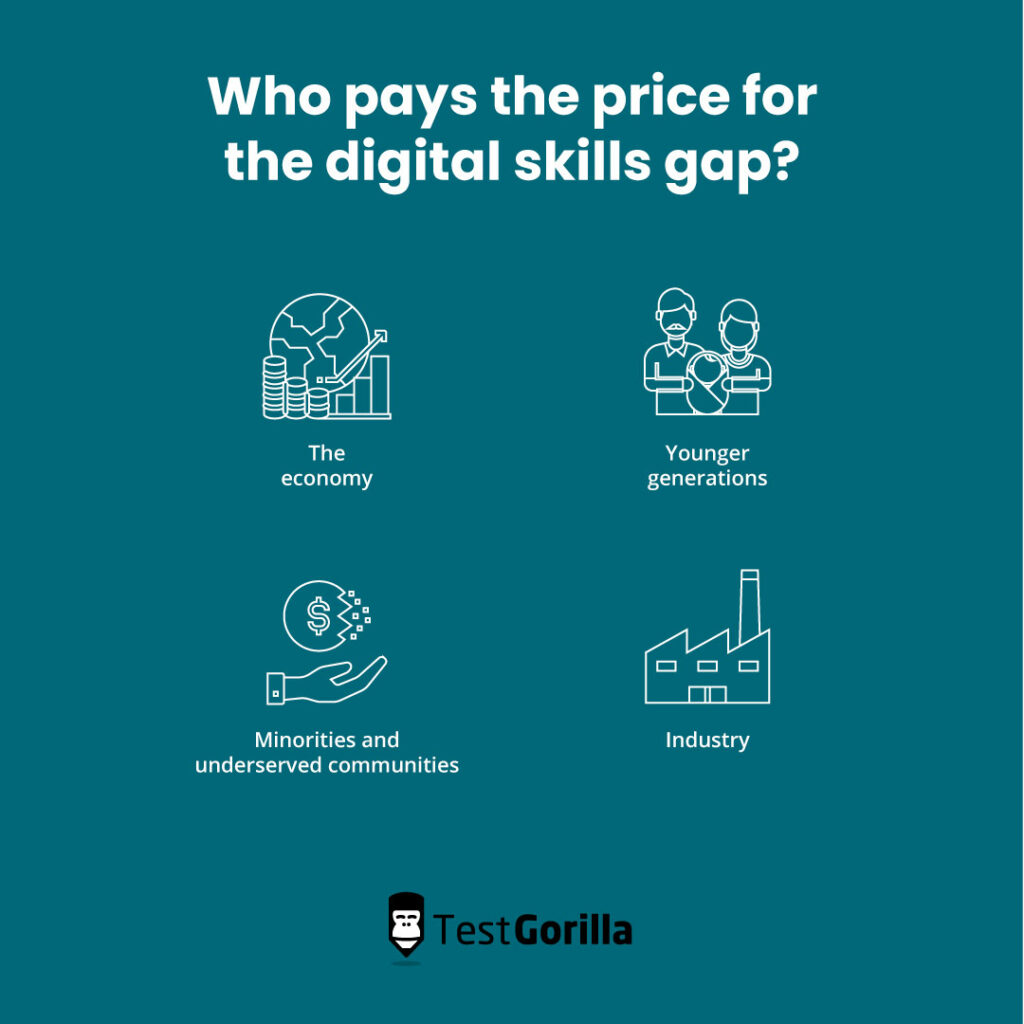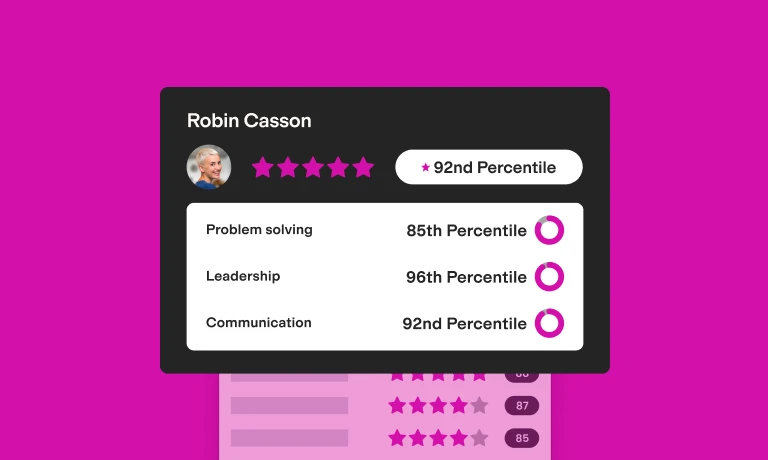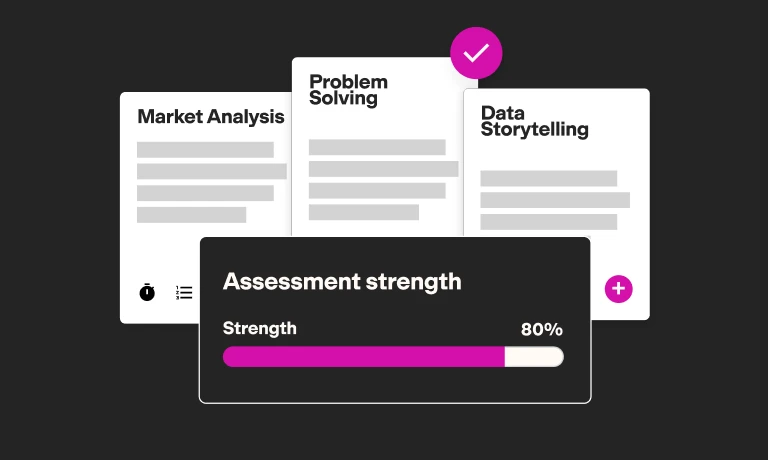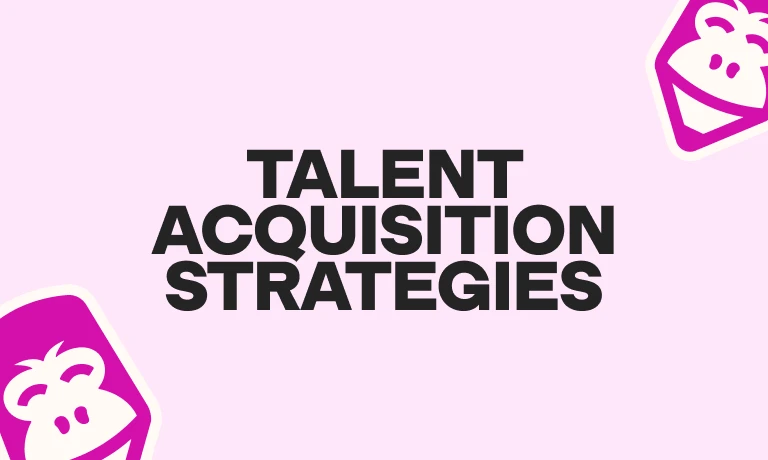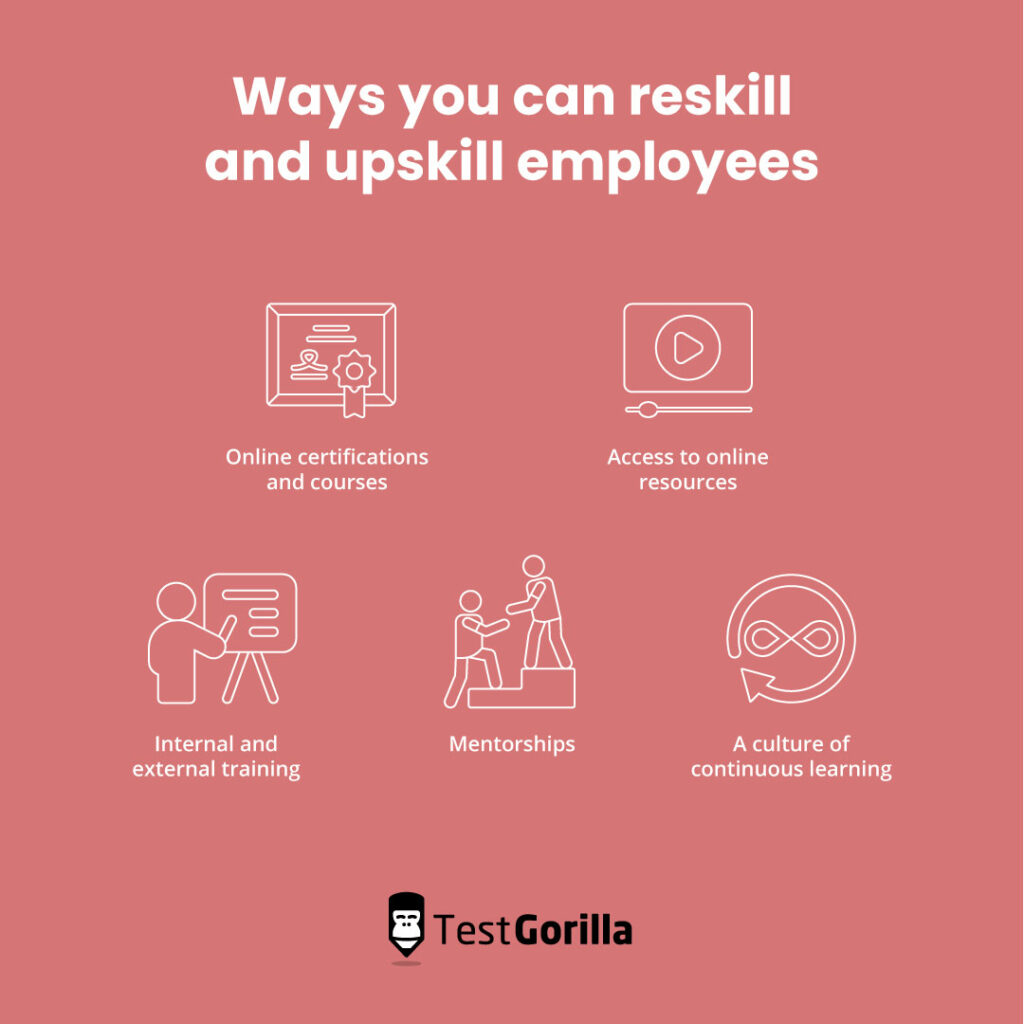Mind the gap: Why digital skills should be on every recruiter’s radar
The laws of supply and demand are simple: if there’s enough of something to go around, it’s less highly valued than when it’s scarce. Then, people will pay more.
So what happens when there’s a global shortage of talent with digital skills and an increase in demand for them? A digital skills gap.
But there are ways to stay ahead of the skills gap and win the war for talent.
For example, prioritizing skills-based hiring to find the digital skills you need. Also, following well-defined best practices can help get you the best talent with all the right digital competencies.
We’ll discuss what the digital skills gap is, its causes, and the impact on companies, economies, candidates, and hiring. Then we’ll take you through what you can do to close the digital skills gap with actionable tips you can adapt to your company.
Table of contents
- What is the digital skills gap?
- What are the causes of the digital skills gap?
- Who pays the price for the digital skills gap?
- How does the digital skills gap impact hiring?
- What’s being done at the policy level to close the digital skills gap?
- What can companies do to close the digital skills gap?
- Skills-based hiring: the key to closing the digital skills gap
What is the digital skills gap?
The digital skills gap is the disconnect between the coveted digital skills needed for modern employment and the lack of those skills in the workforce. And there’s a mismatch between supply and demand: research from the UK’s Learning and Work Institute shows that the need for digital skills across the board will only increase in the future, but digital skills training in formal education is on a downward trend.
The reality is digital skills aren’t just necessary for so-called “knowledge industries” anymore: they’re needed in just about every line of work.
From creating simple documents and spreadsheets to navigating communication channels like Slack and Zoom or advanced digital marketing and web analytics skills—the Fourth Industrial Revolution and the Internet of Things (IoT) demand employees – and employers – keep up.
What are the causes of the digital skills gap?
In a nutshell, a digital skills gap happens when technology develops faster than the (human) skills to match it. So the pool of skilled professionals who understand new digital tools is smaller than the demand for that tech or those skills.
Here are some of the main contributing factors:
The pandemic: With Covid-19 came a labor market disadvantage and disrupted access to education — making it difficult for young people to acquire and pursue digital skills.
Digital poverty: The Learning and Work research shows that nearly one in ten young people don’t have access to a laptop, tablet, or desktop at home in the UK alone. And for lower socioeconomic households with children, one in five don’t have access to the right devices and over one in twenty don’t have internet. These factors are a barrier to e-learning, especially during the lockdown, and have contributed to educational inequality and gaps in digital literacy.
Higher education: Historically, educational institutions have prioritized theoretical learning over skills-based education. Without digital skills training, younger graduates are struggling to gain the technical competencies needed by employers. This has made it more difficult for them to find employment. And, according to our 2022 State of Skills-Based Hiring report, even stand out from the crowd on applications.
The best insights on HR and recruitment, delivered to your inbox.
Biweekly updates. No spam. Unsubscribe any time.
Who pays the price for the digital skills gap?
The digital skills gap has consequences. And, whether we know it or not, we’re all paying the price.
Let’s take a look at how the digital skills gap impacts these key areas:
The economy
To have a prosperous economy, you need a workforce that has the skills current and future labor markets need. In fact, if the skills gap isn’t addressed, 14 G20 countries could risk losing 11.5 trillion in cumulative GDP growth. The UK alone could lose $285 billion in economic growth between 2023 and 2026.
On a macroeconomic level, the skills gap can negatively impact a country’s global competitiveness and considerably increase unemployment rates.
Younger generations
With a rise in unemployment, and education systems that still prioritize theoretical learning, it’s less likely younger people will acquire the right digital skills training, experience, and resources. This is because employers are more likely to hire teen employees for low-skilled jobs, and millennials for middle-skilled positions — leaving Gen Z stuck in the middle and unable to expand their skills or fulfill their potential. Minorities and underserved communities
As mentioned above, digital poverty adds to the skills gap. And it’s more common among underserved communities and young people of color because of unequal access to high-quality training and education (and disparities rooted in racism).
Even when employed, Black and Hispanic youth are still less likely to have advanced applied digital skills when compared with their White counterparts. This puts them at a disadvantage when it comes to landing coveted digital skills-based jobs that pay more.
Industry
Industries across the board are struggling to find talent with digital skills. These include the tech industry at large but, specifically, in roles like DevOps and software engineering. Also, technical or advanced roles across the gaming, financial, and ecommerce industries. In fact, 37% of employers claim their employees lack advanced digital skills.
Employers who struggle to find skilled talent for an open role risk falling behind in innovation, productivity, and corporate dynamism. And 76% of businesses find a lack of digital skills negatively impacts their profitability.
How does the digital skills gap impact hiring?
In a rush to fill open positions, companies can often overlook red flags in candidate applications during the hiring process. These might include the lack or mismatch of skills needed to do the job or a misalignment in job expectations.
It also takes considerable resources to search for candidates with the right skills, especially if external recruiters are hired.
All this can lead to an increase in time-to-hire, mis-hires, employee turnover, and a waste of capital and resources. Especially considering the cost of a mis-hire is 24 times the cost of an employee’s annual salary.
So, what’s being done to close the digital skills gap and hire top-tier talent?
What’s being done at the policy level to close the digital skills gap?
Fortunately, while policies aren’t uniform across the world, governments are aware of the digital skills gap and are working to close it.
“There exists a plethora of aid from government organizations, non-profits, and other entities to assist companies in closing the digital skills gap,” says Tara Furiani, chief executive officer and host at Not the HR Lady, “such as training programs, apprenticeships, and grants. However, the availability of these resources is contingent on the organization and location.”
One noteworthy example is IBM’s “New Collar” program, which aims to close the skills gap by bringing new talent into the tech industry. It provides job opportunities and training for talent with non-traditional educational backgrounds—but with the right skills and competencies and an aptitude for tech.
Another is the National Center for Women & Information Technology (NCWIT) and CODE2040, which provided resources and training for underrepresented groups in the technology industry.
What can companies do to close the digital skills gap?
Organizations have a significant role to play to close the digital skills gap. But to meet future digital skills needs, employers, government, talent, stakeholders, and local leaders all have to work together to make it happen.
Here’s what companies can do to close the digital skills gap.
Perform a skills-gap analysis
HR or hiring managers perform a skills-gap analysis to compare the skills needed by a role with the skills currently possessed by employees. This helps identify any gaps in skills needed to do the job well, so you can create a plan to address them.
Here’s how to perform a skills-gap analysis:
Involve leadership to help define short- and long-term goals: To understand the nature of your company’s future jobs, you need to involve stakeholders. Determine how much they plan to automate, or what future positions they see opening up. And which skills will benefit the company in the future. Then determine your company goals in the next one to five years and the skills needed to complete future tasks and projects.
Decide if it’s an individual or team assessment: Are you testing team or individual competencies? Ideally, both are important for understanding your capacity and any future skills-based resources and training required.
Identify the skills needed to achieve your goals: Consider job descriptions, business goals, company values, and employee feedback. Use them to help you identify any skills employees will need to do their jobs in the future.
Measure internal skills: There are a number of ways to do this, the easiest being skills-based testing for hard and soft skills, language proficiency, personality, culture-add potential, etc.
Identify skills gaps: Analyze the results of employee skills tests and identify any skills gaps.
Create a plan: Once you know the gaps in your desired and existing skills, you can create a plan to address them. For example, providing relevant training and mentorships, or investing in new hires.
Prioritize digital skills
To win the war for talent, you need to prioritize hiring for digital skills. But this also means setting achievable benchmarks for attaining these competencies.
As mentioned above, your skills-gap analysis should help you spot areas of growth for setting your employees up for success, and where you can better align employees with talent or skills shortages.
With skills-based hiring, you can focus on a candidate’s skills, rather than infer their capabilities through qualifications, work history, or background. This opens the door for diverse talent with the right digital skills to excel in the role and gives you a competitive advantage.
To learn about candidates’ digital skills, consider using our interview questions to evaluate computer literacy – designed to give you confidence in a candidate’s digital strengths before the hiring decision.
Evaluate reskill and upskill potential when hiring
It’s important to consider how well a candidate’s skills lend themselves to reskilling and upskilling when hiring. Their ability to grow their skills based on market or company needs is crucial to remain competitive.
For example, most reskilling programs focus on building skills in leadership and management, critical thinking, and advanced data analysis. So it’s crucial to think about how and where your needs might fit in with these or where you might need to focus your resources on upskilling instead.
Skills-based tests can help you better understand candidates’ applied skills and find applicants with the right adjacent skills. So you can reskill and upskill them as necessary and reach your benchmarks.
Provide ongoing reskill and upskill opportunities
Reskilling and upskilling is an ongoing process. For business and employee success, you need to create ongoing opportunities for employee growth.
For example, let’s say an e-commerce company runs a skills-gap analysis. It initially required all employees to have basic coding abilities for web development, then discovers it needs advanced skills in HTML5/CSS3 for future web design projects. So now it can upskill employees through ongoing training, online certifications, or mentorships to fill any skills gaps.
Here are some ways you can reskill and upskill employees:
Online certifications and courses: These give employees the knowledge and skills they need to thrive, without breaking the bank. In fact, HubSpot Academy offers free courses that cover a wide range of digital skills from customer journey management to navigating web analytics tools.
Access to online resources: In addition to courses and certifications, there may be online resources specific to your industry you can offer to help bolster employee skill sets and expertise.
Internal and external training: Ask experienced employees to host internal training on important topics or get external professionals to add a fresh perspective.
Mentorships: By letting higher-level employees mentor junior employees, you can upskill them in a cost-effective way that makes them feel valued.
A culture of continuous learning: Make sure employees feel encouraged and supported when acquiring new skills, and build this into your company culture. That way everyone can contribute and share important knowledge, learning tips, and ideas for further education.
Skills-based hiring: the key to closing the digital skills gap
To better compete in a changing technological landscape, companies need to work with employees to close the digital skills gap. And recognize that digital skills are needed by almost all employees in all industries.
Digital competencies empower workers in diverse industries from auto manufacturing to farming to gaming – and afford them better career mobility, job security, and higher pay.
Making sure the current and future workforce have an education in digital skills is also crucial for economic growth and social justice. For example, leveling the playing field for minorities and underserved communities.
To close the skills gap companies can:
Perform a skills-gap analysis
Prioritize digital skills
Evaluate reskill and upskill potential when hiring
Provide ongoing reskill and upskill opportunities
And when you use skills-based hiring to hire the right profiles — and hire talent based on competencies rather than credentials — you can close the gap and tap into the right skills, faster.
Want a better way to hire digital skills?
Skills-based hiring helps you get in front of the right talent — and land all the right skills.
Download the State of Skills-Based Hiring 2022 report to learn more.
You've scrolled this far
Why not try TestGorilla for free, and see what happens when you put skills first.



